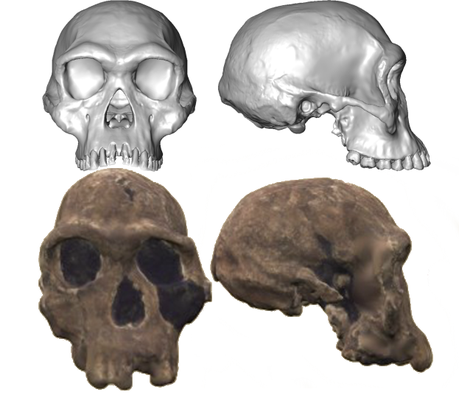Homo habilis could be one of the most important members of the human family; representing the start of our evolution towards the modern human body: walking upright on the ground with large brains. I say “could” be because sadly we haven’t found that many fossils belonging to the species, and most of what we have found is fragmentary or damaged. In fact, there’s even some debate over whether all of these discoveries belong to the same species.
Enter the virtual anthropologists. These are scientists who digitise fossils, allowing them to manipulated inside the computer to compensate for missing or damaged parts. At the end of last year a team of them examined KNM-ER 1813; one of the most complete Homo habilis skulls discovered so far. With a bit of computational tinkering they were able to give us a picture of the complete skull of Homo habilis for the first time.

The reconstructed skull (top) and the original (bottom). Note, they’re probably not exactly to scale because my photo-editing skills suck
The approach of these virtual anthropologists is a complex one, involving multiple steps. First they mirrored complete pieces of the skull, to compensate for missing or damaged bits on the opposite side. With this more complete baseline they were able to figure out bits that had been distorted, allowing them to re-align these sections with the rest of the skull. Finally, for bits where these approaches didn’t work they used the skull of Australopithecus africanus as a guide as it’s the most similar species. Ordinarily this would make me highly skeptical of their findings as it would naturally bias the final result. However, they only used for a very small part of the right side of the skull; so I don’t think it’s a huge issue.
Of course, this is a very simplified version of their methodology. If you want more details their entire paper appears to be freely available, but be warned: you’ll have to deal with phrases like “a reference…landmark configuration was built on the right hemi-cranium…of Sts 5…and then interpolated by thin-plate splins…to a similar configuration digitized on the right hemi-cranium of KNM-ER 1813“. But if thin-plate splins are your cup of tea, feel free to click over.
Ultimately this doesn’t reveal anything new about the species, but it does provide a new source of data for future research.

